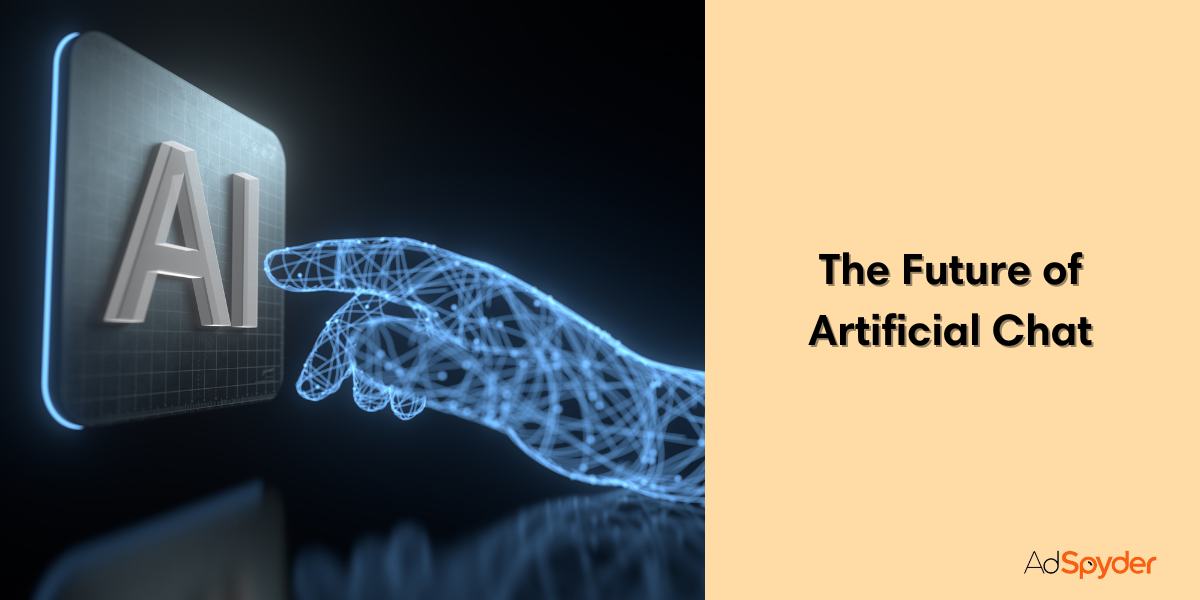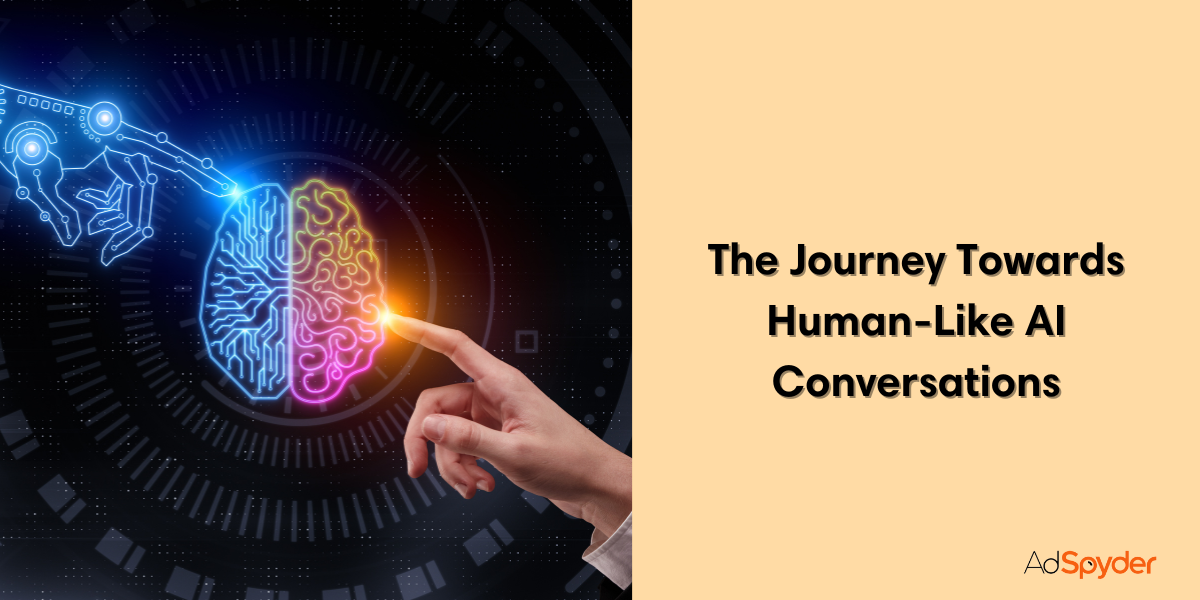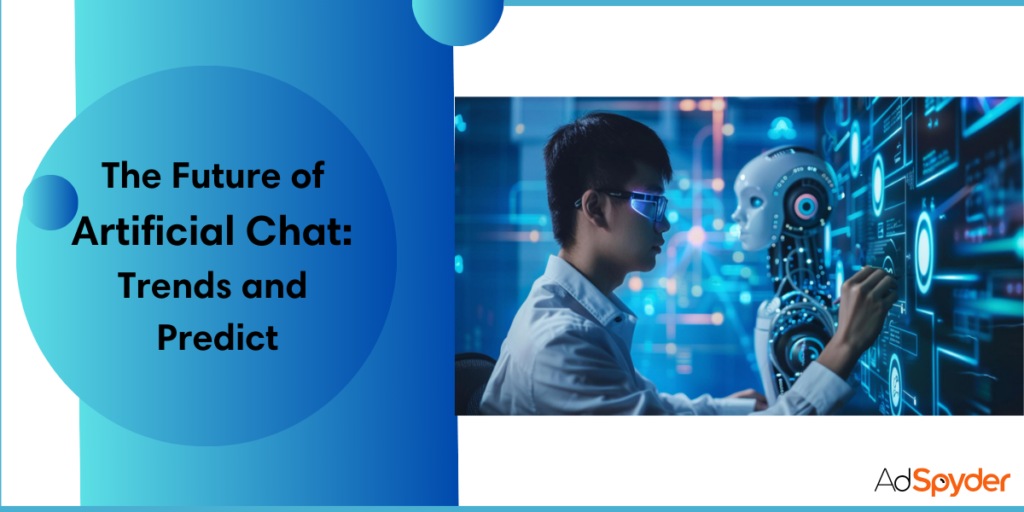Communication and the ways of it have evolved from simple to complex over the years. Eventually, we welcomed AI which has been more than helpful in building the world of Artificial chat. Starting from basic text-based exchanges to voice and chat assistants, artificial chats are becoming better and better at mimicking human conversations. What’s more? What else should we expect in future? We’re going to be diving into all of this in this blog. We’re going to look into this exciting realm of the future of artificial chat and even explore the emerging trends and predictions that shape the way we interact with technology in the coming years.
Ready to Elevate your Marketing Strategy?
Future of Artificial Chat: Key Trends to Watch
We believe that this evolution in artificial chat is bound to revolutionize our old and worn-out ways of communication with machines. The goal is to make conversation with machines feel human-like which will be able to help a lot of brands and businesses connect with their audience. Check out these few key trends that we’ve picked out for you to keep an eye on :
The Rise of the Conversational Future of Artificial Chat
Remember those chatbots we were used to, that barely engaged in more than a single dialogue conversation? Well, those are the things of the past now. The future now lies in the hands of conversational AI where these chatbots will be able to mimic human conversations. The advancements in Natural Language Processing (NLP) and machine learning today will enable these chatbots to understand even complex queries along with following the flow of an ongoing conversation and to be able to adapt their communication style to the user’s emotional state.
Integration with Advanced Technologies
In the near future, we expect to see a seamless integration between chat functionalities and some of the other cutting-edge technologies of today like Augmented Reality (AR) and Virtual Reality (VR). Imagine a virtual assistant that is capable of guiding you through a repair process using AR overlays; or maybe one that personalized your VR experience based on your personal preferences. How cool, right?
The Power of Emotion Recognition
For any developing chat assistant, in order to have engaging chat conversations, the basic necessity is the ability to understand and respond to human emotions appropriately. As these chatbots become more sophisticated with time, they will even incorporate sentiment analysis to gauge user emotions from text and voice cues. This will eventually allow chatbots to provide even more empathetic and personalized interactions.
Omnichannel Communication
The future of chat lies in a seamless omnichannel experience. Users expect to be able to seamlessly switch between different communication channels (website, mobile app, social media) while maintaining continuity in their conversation with a chatbot. This will require chatbots to be integrated across various platforms and share user data securely. It will also require integration with ad campaigns from Reddit, Google, Facebook and other platforms for awareness and easy explanation for the customers.
Focus on Explainability and Transparency
As AI chatbots become more complex, there’s a growing need for explainability and transparency. Users should understand how chatbots arrive at their decisions and can request clarification or challenge responses. This will build trust and confidence in AI-powered interactions.
These trends highlight the exciting possibilities that lie ahead for AI chat. From natural and engaging conversations to personalized experiences across various platforms, the future of chat promises to be more human-centric and efficient than ever before.
The Potential Impact of the Future of Artificial Chat: A Double-Edged Sword

The rise of AI chat has the potential to significantly impact various aspects of our lives. Here’s a closer look at the potential benefits and drawbacks:
Benefits
The potential benefits of Artificial chat are :
- Enhanced Customer Service: AI chatbots can provide 24/7 customer support, answer complex questions, and even resolve customer complaints efficiently. This leads to increased customer satisfaction and improved brand loyalty.
- Personalized Interactions: AI chatbots can leverage user data to personalize communication, offer relevant recommendations, and tailor their responses to individual needs. This creates a more engaging and user-friendly experience. For example, if a user arrives at the chatbot via location based targeted ad, this information can be passed to the chatbot, and it provides some personalised communication to the user.
- Increased Efficiency: Chatbots can handle routine tasks and answer basic inquiries, freeing up human resources for more complex interactions. This leads to increased efficiency and cost savings for businesses.
- Educational Tools: AI chatbots can be used as personalized learning tools, providing students with immediate feedback, answering questions, and adapting to individual learning styles.
- Accessibility and Inclusivity: AI chatbots can break down language barriers and platforms, and offer communication options for people with disabilities, promoting accessibility and inclusivity. For example, a user can see a Facebook video ad on a product and can be encouraged to interact with the chat without having to leave the Facebook ecosystem.
Drawbacks
Here are its drawbacks :
- Job Displacement: The increased reliance on AI chatbots for customer service tasks may lead to job displacement in certain sectors. Businesses need to focus on retraining and re-skilling initiatives to mitigate this impact.
- Bias and Discrimination: AI chatbots trained on biased data may perpetuate stereotypes and discrimination. Careful data selection and training procedures are crucial to ensure fair and unbiased interactions.
- Privacy Concerns: The use of AI chatbots raises concerns about data privacy and security. Robust security measures and clear data collection policies are essential to build user trust.
- Lack of Human Connection: While AI chatbots can be efficient, they may lack the ability to provide the same level of empathy and emotional support as human interaction. Businesses need to strike a balance between AI and human interaction.
- Overdependence on Technology: Reliance on AI chatbots for communication may hinder our ability to develop real-world social and communication skills, particularly for younger generations.
By acknowledging these potential drawbacks and implementing responsible development practices, we can harness the power of AI chat to create a future of enhanced communication that benefits both individuals and businesses.
The Future of Artificial Chat

The future of artificial chat is brimming with exciting possibilities. Here are some predictions on how AI chat will continue to evolve:
The Rise of Embodied AI
Imagine interacting with a chatbot that has a physical form, not just a virtual presence. The future may see the emergence of embodied AI, where chatbots are integrated into robots or other physical avatars. This could revolutionize customer service interactions in physical stores or enhance the user experience in virtual environments.
Hyper-Personalization with Contextual Awareness
AI chatbots will become even more adept at understanding the context of a conversation. They will leverage user data, past interactions, and even environmental factors to personalize responses in real-time. Imagine a chatbot that recommends a restaurant based on your current location, dietary restrictions, and past dining preferences. Integrating AI chatbot across various touchpoints in the customers’ journey provides seamless customer experience with minimal issues.
The Power of Biometric Integration
The future of chat may involve integrating AI chatbots with biometric technology. This could allow chatbots to analyze facial expressions, vocal tones, and even physiological responses to tailor their communication and identify user needs more accurately. However, ethical considerations around user privacy and data security will be paramount.
The Rise of Emotionally Intelligent Chatbots
AI chatbots are moving beyond simply understanding emotions to responding with emotional intelligence. This means they can not only recognize emotions but also respond in a way that is empathetic, supportive, and appropriate to the situation. This will be crucial for applications like mental health support or crisis intervention chatbots.
The Blurring Lines Between Human and Machine
Advancements in AI will make it increasingly difficult to distinguish between human and machine interaction. This raises ethical questions about transparency and user trust. In the future, it may be essential for chatbots to disclose their AI nature to maintain user trust and ethical communication practices.
These predictions paint a picture of a future where AI chat is seamlessly integrated into our lives, offering personalized and emotionally intelligent communication across various contexts. From hyper-personalized recommendations to emotionally supportive interactions, the future of AI chat promises to be a fascinating and transformative journey.
The Journey Towards Human-Like AI Conversations: Challenges and Opportunities

The path towards creating truly human-like AI conversations is paved with both challenges and exciting opportunities. Here’s a closer look at some of the hurdles we need to overcome and the potential rewards that lie ahead:
Future of Artificial Chat: Challenges
The challenges towards our goal are many, few of which have been tackled already and some are yet to be.
The Turing Test Enigma
The Turing Test, a benchmark for a machine’s ability to exhibit intelligent behavior equivalent to, or indistinguishable from, that of a human, remains a significant challenge. Creating AI chatbots that can consistently pass the Turing Test and engage in truly nuanced conversations is a complex task requiring significant advancements in AI technology.
Understanding Context and Nuance
Human communication relies heavily on context, unspoken cues, and the ability to understand subtle nuances. Developing AI chatbots that can effectively interpret these complexities and respond appropriately remains a challenge. Humor, sarcasm, and cultural references are just a few examples of areas where AI chatbots often struggle.
The Emotional Barrier
Human emotions are intricate and multifaceted. While AI chatbots are becoming more adept at recognizing emotions, replicating the full spectrum of human emotional intelligence and responding with empathy and understanding remains a significant hurdle.
Combating Bias and Stereotypes
AI chatbots trained on biased data can perpetuate stereotypes and discriminatory practices. Developing robust data cleansing techniques and implementing fair AI development practices are crucial to ensure unbiased interactions.
Future of Artificial Chat: Opportunities
Here are the opportunities that we have to look forward to :
Enhanced Human-Machine Collaboration
AI chatbots can become powerful tools for collaboration. Imagine an AI assistant who can anticipate your needs, research relevant information, and present it in a concise and actionable manner, streamlining workflows and boosting productivity.
Personalized Learning and Education
AI chatbots can personalize the learning experience by catering to individual learning styles, providing real-time feedback, and offering tailored support. This can revolutionize education, making it more engaging and effective for all learners.
Empowering Accessibility and Inclusivity
AI chatbots can break down language barriers and offer communication options for people with disabilities. Imagine a chatbot that can translate languages in real-time or adapt communication styles to cater to individuals with visual or auditory impairments.
Mental Health Support and Well-being
AI chatbots can offer basic mental health support, provide resources for crisis intervention, and even act as virtual companions for those struggling with loneliness or isolation. While not a replacement for human therapy, AI chatbots can offer a vital first line of support and encourage help-seeking behavior.
The Future of Entertainment
AI chatbots can create interactive and immersive entertainment experiences. Imagine a chatbot that can tailor a story to your preferences, act as a virtual game master, or even personalize your music recommendations based on your mood and past listening habits.
Overcoming the challenges and harnessing the opportunities will be crucial in shaping the future of AI chat. As AI technology continues to evolve, we can expect to see chatbots that are not only functionally sophisticated but also emotionally intelligent and capable of engaging in natural, human-like conversations.
FAQs
While AI chatbots excel at handling routine inquiries and basic troubleshooting, complex issues often require the human touch. However, AI chatbots will play a crucial role in streamlining customer service processes and freeing up human agents to focus on intricate customer interactions.
Businesses should implement robust security measures like data encryption, secure storage practices, and clear user consent for data collection. Additionally, adhering to data privacy regulations like GDPR and CCPA is crucial
Users should be aware that they are interacting with a chatbot, not a human agent. Additionally, ensuring unbiased responses and responsible data collection practices are crucial to avoid discrimination and privacy concerns.
Businesses should stay informed about advancements in AI chat technology. It’s important to develop a clear strategy for integrating AI chatbots into their communication channels while considering the potential impact on human resources and customer service workflows.
While AI chatbots will handle many tasks, human skills like critical thinking, problem-solving, and empathy will remain crucial. The ability to manage and oversee AI chatbots, analyze data to improve their performance, and ensure ethical implementation will be valuable skill sets.
AI chat could have both positive and negative impacts. On the positive side, it may encourage clear and concise communication due to the way we interact with chatbots. However, overreliance on AI chat could hinder our ability to develop real-world communication skills and navigate nuanced social interactions.
Conclusion
The future of communication is undoubtedly conversational. AI chatbots are no longer a futuristic concept; they are a tangible reality that is transforming the way we interact with technology and each other. As AI chat technology continues to evolve, the lines between human and machine interaction will likely blur further.
By embracing the power of AI chat responsibly and fostering a culture of human-machine collaboration, we can create a future where communication is more efficient, personalized, and accessible for all. The journey towards truly human-like AI conversations is ongoing, but the possibilities are vast and hold the potential to revolutionize the way we connect, learn, and interact with the world around us.




